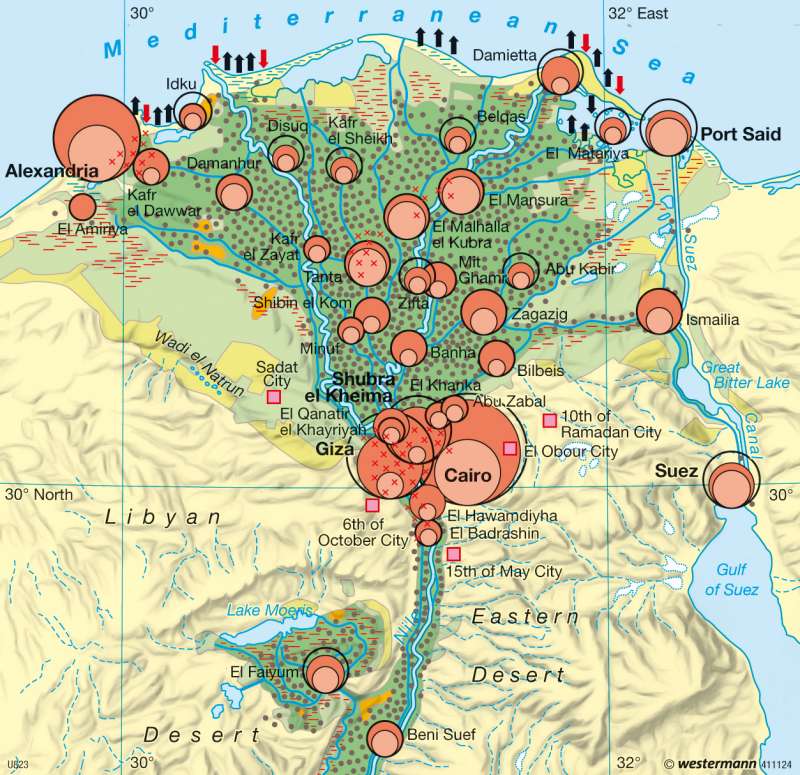Nile Delta — Population growth
Africa - Physical
978-3-14-100790-9 | Page 152 | Ill. 3

Information
The map shows the distribution and growth of the population in the Nile Delta and the northern part of the Nile Valley. It also illustrates the loss of existing and the winning of new areas of cultivation. The map thus draws attention to a problem that cannot be viewed in isolation from the social and economic situation of the country. A deterministic interpretation, emphasizing only natural factors, population growth and living capacity, would fail to do justice to Egypt's complex development.Even today, the population of Egypt — now numbering more than 70 million — is concentrated almost exclusively within the cultivated land area, while the desert regions, which account for 96 percent of the land surface, are practically empty. In Upper Egypt, on account of the morphology of the Nile Valley, the fertile cultivated area is restricted to a narrow strip only a few kilometres wide, while the Nile Delta opens out in a northward direction towards the Mediterranean in a triangle whose sides are some 180 kilometres in length. A special case is the Faiyum Oasis, which is fed by a branch of the Nile that ends in the Lake of Qarun. The capital city, Cairo, lies at the intersection between Upper and Lower Egypt, which is crucial for the country's physical structure. As can be clearly seen from the map, population distribution in Egypt is characterized by extreme contrasts in density. Some 80 percent of all Egyptians live in the Delta and in the Cairo metropolis.
Population Growth, Urbanization and Land Shortage
The physical distribution of settlement has not changed fundamentally since ancient times. However the population has risen from some 4 million people at the beginning of the 19th century to around 70 million today. Great efforts have been made in the last two centuries to extend the area of cultivation into the desert and to intensify irrigation, but the available crop area per head of population has nevertheless continued to shrink in this period. The Nile Valley is thus one of the most densely-populated regions in the world, and the Cairo metropolis with its approximately 15 million inhabitants is one of the world's largest conurbations.
In the last 100 years the urban proportion of the total population has risen from 20 to nearly 50 percent. This development has been accompanied by a great spatial expansion of the cities and rural settlements, which has led to agricultural areas becoming increasingly built over. The construction of new buildings on agricultural land has now been significantly restricted by statutory measures, and in the towns and villages of the Nile Delta there has also been vertical expansion by raising the height of existing houses.
Aswan High Dam and Land Reclamation
With the construction of the High Dam at Aswan in the 1960s, Egypt pursued a number of objectives. These included a complete conversion from basin to channel irrigation also in Upper Egypt, an intensification in the use of the existing area of cultivation by enabling two harvests per year, new land reclamation and electricity generation; the latter being intended as the basis for a planned but only partially realized industrialization. As a long-term reservoir, the High Dam was also expected to provide greater security against fluctuations in the water level of the Nile and against drought.
The conversion to all-year-round permanent irrigation has had both positive and negative consequences. Among the disadvantages are that soil fertility has declined as a result of the absence of the regular washing-out of the soil and the lack of deposition of Nile silt, while at the same time salinization and the development of marsh have become more intensive, especially in areas on the fringe of the Delta and in the Faiyum Oasis. The reduced sediment load in the river has also resulted in increased erosion on the banks of the river and along the Delta coast. Positive effects of the dam have been the intensification of irrigation, power generation, and mitigation of the long-standing fluctuations in the water level of the Nile. The dam has been of greatest importance for the expansion of the area of cultivation, especially to the west and east of the Delta, and even on the eastern side of the Suez Canal in the Sinai, and today for the Toshka project.
D. Müller-Mahn; Ü: J. Attfield




